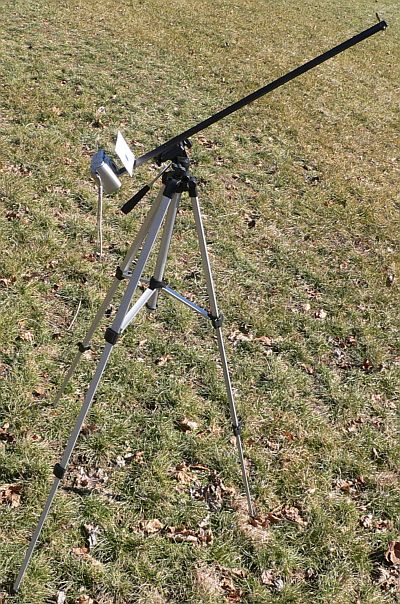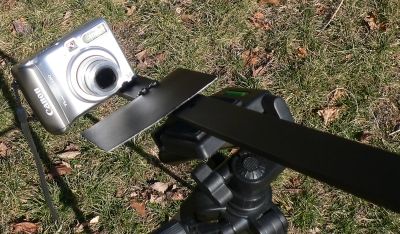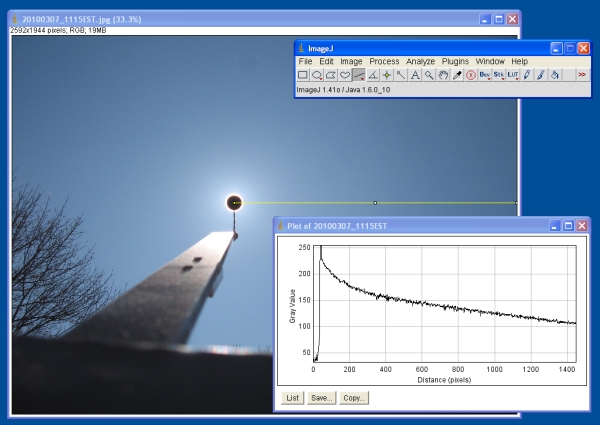 |
Photographing the Solar Aureole: A Different Way of Looking at Particulates and Scattered Light in the Atmosphere
David R. Brooks, March 2008
|
NOTE: This web page describes how to photograph the sky in the immediate vicinity of the sun. NEVER LOOK DIRECTLY AT THE SUN, EVEN WITH SUNGLASSES,
AS THIS CAN PERMANENTLY DAMAGE YOUR EYES!! It is also possible that the procedures described below may damage your digital camera.
|
|
Photographing the solar aureole
 |
 |
| Figure 1. Tripod fixture for photographing the solar aureole. |
Elsewhere on this web site there are descriptions of using sun photometers to measure aerosol optical thickness and pyranometers
to measure total solar radiation (insolation) reaching Earth's surface. Both these measurements, and especially sun photometer measurements,
are influenced by the presence of aerosols (particulates) in the atmosphere. Aerosols cause scattering of sunlight -- the more aerosols, the more scattering. Because some scattered sunlight
returns to space, increased particulates can also decrease insolation.
There is another very interesting observation that is related to particulates in the atmosphere. Scattering of sunlight produces the solar aureole, which appears as a whitish ring
around the sun. The size of the aureole is related to the amount of scattering. With very clean air, and/or at high-elevation observing sites, the aureole is very small. In hazy skies,
the aureole can be very large and bright. This is true on typical summer days in temperature and tropical climates. Although solar aureoles are easy to observe,
until recently it has not been easy to analyze them quantitatively. However, digital photography provides a very simple and direct way to analyze aureoles. This requires only:
1. A digital camera with manual controls for setting focus, exposure, and f-stop.
2. Image-processing software for measuring the brightness of the sky along a line from the edge of the sun to some other point in the sky.
Currently, many digital cameras, even relatively inexpensive ones, include full manual control capabilities. The image resolution is not
critical for this application -- 5 megapixel images are common even for low-end cameras and that is more than sufficient for this purpose.
A large optical zoom capability is also not needed. In fact, none of the many sophisticated capabilities commonly found in digital cameras
are needed for this project.
As for the software required to analyze aureole images, ImageJ, developed by the United States National Institutes of Health, is perfect for this task, and it is free!
To photograph the sky around the sun, it is necessary to block the solar disk itself. Otherwise, the light from the sun will "wipe out" the rest of the image.
In principle, you can use the corner of a building or some other object. However, there is an important consideration when using digital cameras to photograph
the solar aureole. Unlike film cameras, digital cameras capture images without a physical shutter between the lens and the electronic equivalent of a film frame.
This means that the lens is, essentially, always open when the camera is turned on. (This is true even if the camera includes an optical viewfinder.)
With this arrangement, pointing the camera directly at the sun is definitely not a good idea. It would be even a worse idea to point the camera at
the sun by looking through an optical viewfinder! Sunlight is extremely intense and focusing sunlight through a lens can permanently damage your camera's
light detecting surface, not to mention your eyes! The instruction manuals of some digital cameras include specific warnings against pointing the camera at the sun.
The solution is to build a simple fixture that blocks light coming directly from the solar disk. Figure 1 shows such a fixture, mounted on
a standard camera tripod. The mounting bracket is made from a 66-cm long piece of 1/4" × 1" aluminum bar stock, available at hardware and building supply stores.
The camera is mounted at one end of the bar with a 1/4"-20 screw, using the standard threaded tripod mount found on cameras. Another hole further down the bar
is tapped for a 1/4"-20 screw, to attach it to the tripod. In between, a small hinge supports a sheet of thin aluminum approximately the same size as the camera body.
This protects the camera from the sun while the setup is being positioned.
A penny is fastened with epoxy to a short piece of #14 copper wire and attached to the end of the bar with a #8 machine screw and washer.
When the camera shown in Figure 1 is turned on with its lens extended, the end of the lens is about 61 cm from the penny. The penny should just cover the solar disk,
leaving only the solar aureole and the sky around it. The shadow cast by the penny should just cover the camera's lens. The precise positioning of the penny needs to be
determined by trial and error, as described below. Finally, the entire assembly visible from the camera should be spray-painted flat black to
minimize light reflections.
To position the penny relative to the camera lens, paste a paper label to the side of the aluminum sheet facing away from the camera. With the camera turned off,
flip the aluminum sheet down out of the way. Adjust the tripod so the shadow from the penny is centered over the camera’s lens cover. Then flip the sheet into the "up"
position and draw a circle around the shadow cast by the penny.
To photograph the aureole, position the aluminum sheet in the "up" position to keep sunlight off the camera face. Turn the camera on, manually set its shortest
exposure and smallest available aperture (largest f-stop), and focus it at infinity. Then adjust the tripod so the sun's shadow is centered on the circular target.
When the position is set, flip the aluminum sheet down out of the way and take the picture, as shown in the lower photo. The camera shown in Figure 1 is a Canon PowerShot
A530 set at 1/1600 s and f-5.6. The camera retains these settings once they are set in manual mode, but the focus must still be set manually each time the camera is used.
Only a few seconds are required to align the penny's shadow and take a photo, during which time the sun will not have moved significantly. The result is an image
that blocks direct light from the sun, but gives a clear view of the surrounding aureole. I usually take three quick photos and select the one that shows the aureole the most symmetrically
oriented around the shadow from the penny. At a shutter speed this fast, a little "jiggle" from the tripod won't be a problem if you move it slightly.
Intepreting aureole images
 |
| Figure 2. Aureole photo, 12:25 EDT, 07 March 2010, processed by ImageJ software. |
Figure 2 shows ImageJ processing for an aureole image taken on a typical clear day in early spring. (The aerosol optical thickness values at 505 nm and 625 nm, obtained
with measurements from the sun photometer described elsewhere on this web site, were about 0.11 and 0.08.) Using one of ImageJ's processing tools, a straight line has been drawn
from the center of the disk
covering the sun to the upper right hand corner of the picture. The graph shows the brightness along this line, analyzed as an 8-bit grayscale value between 0 and 255.
The data plotted on the graph can be saved as a text file so they can be imported into a spreadsheet for further analysis.
The density plot shown in Figure 2 will help to determine when the penny is correctly positioned to cover only the solar disk. The distance from the lens to the penny is
right when the density plot on a very clear day reaches a value of 255—the maximum brightness the image will record—just at the edge of the disk. If there is a wider
band of 255 values around the shadow, then the disk is too far away (or too small). If the density doesn’t reach 255, then the disk is too close (or too large).
For your camera, you may need to use a disk of a different size placed at a different distance from the lens.
The quantitative interpretation of aureoles, and particularly their relationship to aerosol optical thickness, remains an open and interesting question.
However, it is easy to observe qualitatively some pronounced changes in the solar aureole that depend on atmospheric conditions.
Figure 3 shows density plots for two aureoles taken six days apart. The top plot was taken during a day on which some early morning cirrus clouds
appeared to disappear by mid-day. However, the aureole photo showed what appeared to be the remains of some very thin and wispy cirrus clouds around the sun.
In any case,
the size of the aureole is clearly larger than it is in the lower photo, which is associated with the bottom density plot. This photo was taken following the
very dramatic passage of a cold front. The day before the photo was taken, air temperature dropped from 18°C around midday to 1°C by late afternoon, with high winds.

|  |
 |
| Figure 3. Aureole photos taken under different sky conditions. |
Aerosol optical thickness (AOT) values at 505 nm (green) and 625 nm (red) are shown on the graph. The values are significantly smaller on March 9 than on March 3.
If cirrus clouds really were present during the
measurement on March 3, then the AOT values are suspect. Nonetheless, these are conditions under which almost any observer would have been willing to
collect sun photometer data.
The fact that decisions about whether an observer has an "unobstructed" view of the sun, as required for sun photometry, are difficult for human observers
(and for computer-based cloud detection algorithms, too), reinforces the value of this kind of photography.
The very rapid decrease in the aureole density seen on March 9 is observed only under conditions of very clean skies with very low AOT values.
For the purpose of comparing and analyzing aureole images, it is important always to use the same camera, because different cameras process light differently and
have a different field of view, and always to use the same exposure and f-stop. (Both images in Figure 3 were taken at 1/1600 s, f-5.6.) If the camera is allowed to
use its automatic exposure settings, you will not be able to compare images taken at different times under different sky conditions. If you can afford it, it is a good idea
to devote a camera exclusively to this project, so it can be left permanently mounted on the fixture.
It is worth repeating here the warning given earlier about aureole photography. If you are careless about focusing direct sunlight through your
camera's lens, or perhaps even if you are careful, it is possible to permanently damage your camera. So, undertake this project with that risk in mind.
If you purchase a camera specifically for this project, get the least expensive model that will provide you with manual settings for focus, exposure time, and f-stop.
A simpler version of this project is to take photos of the sky which do not include the sun. A series of photos of the same scene, looking north,
for example, taken daily near solar noon provide a very interesting record of sky conditions, including haze. You should include the horizon in such photos.
If you are fortunate enough to be able to see some distant objects, such as tall buildings or mountains, from your observing site, the visibility of these objects
will be related to aerosols and water vapor. These images, too, can be analyzed with ImageJ, by measuring grayscale brightness along a line drawn vertically upward
from just below the horizon, or by calculating the average brightness of a selected uniform area within a distant object.
As with the aureole photos, you should use the same camera with the same manually set exposure and f-stop to allow comparisons
under different conditions. It might be interesting to compare photos taken with fixed exposure and f-stop with photos of the same
scene at the same time taken with automatic camera settings. The automatic settings will probably produce images that look "better" than images taken with
manual settings because your camera will try to produce an image that is "properly" exposed, as defined by its light-processing algorithms.
Digital photography has progressed very rapidly in the first few years of the 21st century. The same inexpensive cameras and software that make
digital photography so much fun can also be used to do some very interesting science. Professional atmospheric scientists have perhaps not yet thought enough
about the opportunities this technology provides. As a result, this is an easily accessible area of investigation that can be very rewarding for students,
teachers, and other non-specialists. Even individual photos of atmospheric conditions can be interesting, but as with all kinds of atmospheric measurements,
consistent long-term records will be much more valuable.
Acknowledgements: My colleague, Forrest Mims, has been taking solar aureole photographs for many years, and he has inspired my much more
recent interest in this project.
You can find more information about Mims' work with aureole and sky photography here.






